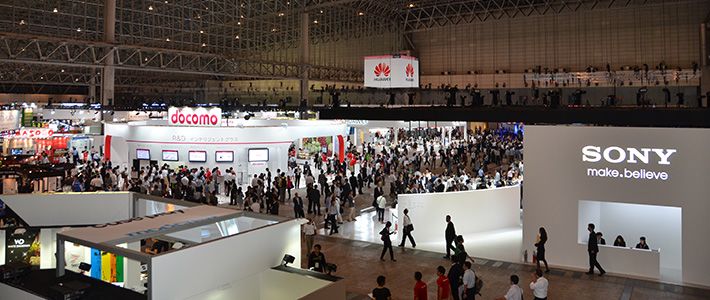
Autos and Electronics Converge at CEATEC 2013
Economy- English
- 日本語
- 简体字
- 繁體字
- Français
- Español
- العربية
- Русский
Car Makers Get In On the Act
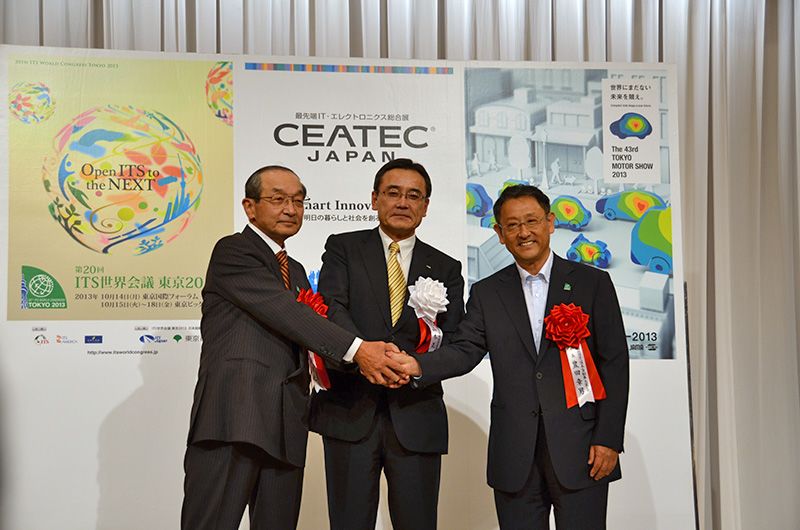 (From left) ITS Japan President Watanabe Hiroyuki, a senior technical executive at Toyota; Japan Electronics and Information Technology Industries Association Vice President Yamamoto Masami, the president of Fujitsu; and Japan Automobile Manufacturers Association Chairman Toyoda Akio, the president of Toyota.
(From left) ITS Japan President Watanabe Hiroyuki, a senior technical executive at Toyota; Japan Electronics and Information Technology Industries Association Vice President Yamamoto Masami, the president of Fujitsu; and Japan Automobile Manufacturers Association Chairman Toyoda Akio, the president of Toyota.
The annual Combined Exhibition of Advanced Technologies, or CEATEC, is devoted to publicizing the latest trends and innovations in electronics and information technology and depicting lifestyles that embrace them. Attention tends to focus on exhibits by the big Japanese electronics firms, including Panasonic, Sony, Sharp, Mitsubishi Electric, Fujitsu, and Toshiba. Not Hitachi, though, which stopped manufacturing TVs in Japan last year and didn’t exhibit this year. It was car makers, not the electronics giants, that made a big splash this year.
In 2011 Nissan and Mitsubishi Motors participated in CEATEC. Last year Nissan and Toyota took part. This year these two were joined by first-time exhibitors Honda and Mazda. Japanese electronics manufacturers, who have lost their edge in the consumer market to newcomers like Apple and Samsung, have been concentrating on developing new technology for use in cars. The electronics and auto industries seem to be moving quickly toward a common destination.
There were indications of this at the opening reception, held at a hotel near the venue. Japan Automobile Manufacturers Association Chairman Toyoda Akio, the president of Toyota, was among the luminaries posing for photographers. “With the arrival of electric-powered, IT-equipped cars,” Toyoda said, “automobiles have become traveling information devices. As further advances in IT and electronics are made, the automobile will evolve as well.”
This autumn, CEATEC was followed by the 2013 ITS World Congress, an event devoted to “intelligent transport systems,” held in Tokyo from October 14 to 18. Still to come is the 43rd Tokyo Motor Show, which will run from November 22 to December 1. At the photo session for the CEATEC opening reception it was announced that these three events are being staged cooperatively. The fact that Toyota’s president was on hand, with all the hubbub his presence generated, made it clear that cars would be playing a starring role.
Nissan: A Self-driving Car
Today’s automobiles come equipped with all manner of electronic devices and components. Under the hood virtually everything’s electronic. There’s little left for the driver to do other than turn the steering wheel—and advances in electronics are now encroaching on that final frontier.
At CEATEC, Nissan put its “autonomous drive” technology on display for the first time in Japan, using a special demonstration course set up inside the exhibition hall, designed to simulate a city driving route in Japan. The vehicle, an advanced version of the Leaf, Nissan’s electric car, was outfitted with five laser scanners and five cameras covering every possible angle, providing a complete grasp of driving conditions in real time. The brakes, steering wheel, and other controls were operated by the vehicle itself.
When it encounters another car, the Nissan vehicle, which is also equipped with artificial intelligence capabilities, registers the other vehicle’s movements and selects the appropriate action from the various alternatives stored in its memory. Even in fairly complicated scenarios, such as when entering an uncontrolled intersection or passing a parked car, the demonstration vehicle correctly assesses the conditions and safely negotiates them.
But rather than this sort of “autonomous” driving, the technology demonstrated at the exhibition is intended to accommodate the presence of a human driver. Even in autonomous driving mode, the driver can intervene and take manual control of the vehicle when necessary. Nissan is calling its new technology the Advanced Driver Assist System.
Companies around the world, including the US IT giant Google, are now competing to develop “autonomous cars.” In August, when Nissan unveiled its autonomous vehicle in the United States, the company announced that it will aim to put passenger cars incorporating the technology on the market by 2020. The plan is to test the vehicles on public roads, refine the technology, and, finally, make the automated driving system available for actual use.
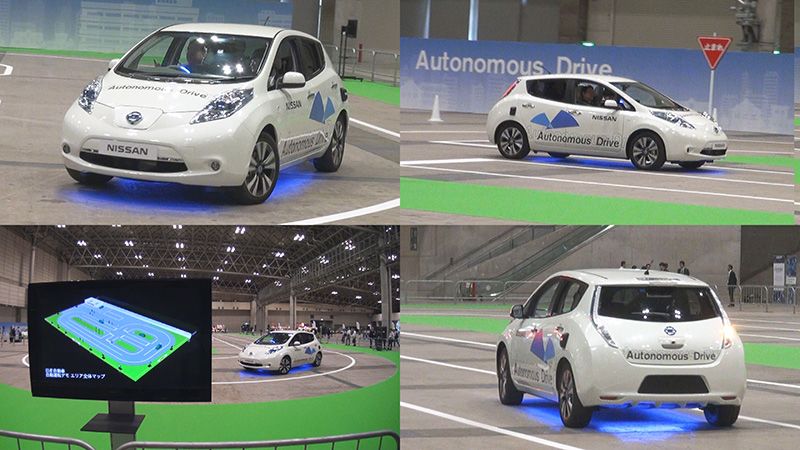 Nissan’s “autonomous drive” technology on display at CEATEC 2013.
Nissan’s “autonomous drive” technology on display at CEATEC 2013.
Fujitsu: Drowsiness Detection
Technology designed to promote safe driving was prominently featured at the booths for the manufacturers of electrics and electronics components, including Fujitsu’s drowsiness detection technology. With this technology, intended for truckers, bus drivers, and other long-distance motorists, a sensor worn on the ear monitors the driver’s pulse, and the system emits a warning in response to changes in the pulse rate indicating that the driver is getting sleepy. Trucking firms and bus lines can incorporate this into their existing control systems, collect reports on the incidence of drowsiness among their drivers, and compile hazard maps identifying locations where drivers are particularly susceptible to drowsiness.
Alps Electric, a major manufacturer of electronic components, showed off a futuristic driver’s seat equipped with sensors that monitor and analyze the occupant’s behavior and eye movements and anticipate what the driver will do next. The aim is to facilitate safe and comfortable driving.
Among the automakers, Mazda, a newcomer to CEATEC, presented a newly developed human-machine interface as part of its “heads-up cockpit” concept. Designed to minimize factors that contribute to inattentive driving, the system features a display that the driver can see without looking down, “eyes-free” controls. The features will be incorporated into a new model in the company’s “Axela” range, to be known internationally by the name “Mazda 3.” The new car will go on sale in November.
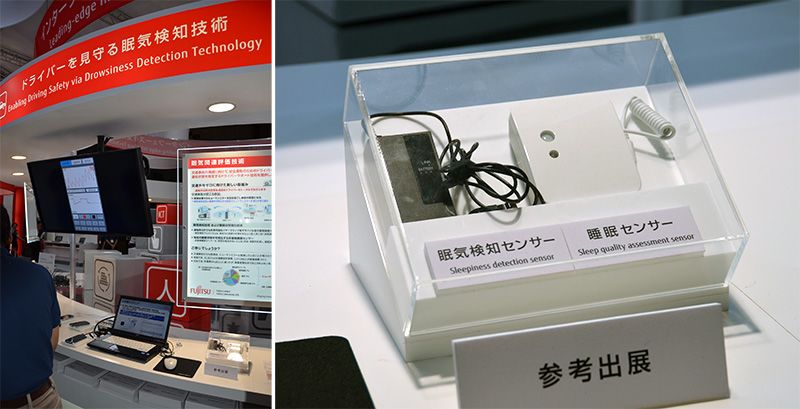 “Drowsiness Detection Technology” on display at the Fujitsu exhibit.
“Drowsiness Detection Technology” on display at the Fujitsu exhibit.
Clarion and Google: Voice-driven Navigation
As mobile-phone mapping applications have improved, the car-navigation industry has seen its market plummet and is struggling to survive. Pioneer, the industry leader, seized the occasion to exhibit a vehicle interior that it claims will enable intuitive operation of the vehicle by enlisting the human capacity for perception and recognition. Information about roads, routes, and the like is displayed on the inside of the windshield, where the driver can see it without taking his or her eyes off the road. The steering wheel is equipped to provide “tactile feedback,” enabling it to alert the driver when a traffic light changes, for example.
Clarion, Japan’s fifth largest car navigation firm, is collaborating with Google. At CEATEC, Clarion displayed its new “Intelligent Voice” system, which incorporates Google’s voice recognition technology as well as the directory of business locations known as Google Places. The system will search for and display desired information based on spoken input. The existing system relies on Japanese-language input, but systems using English and French are expected to become available outside Japan soon.
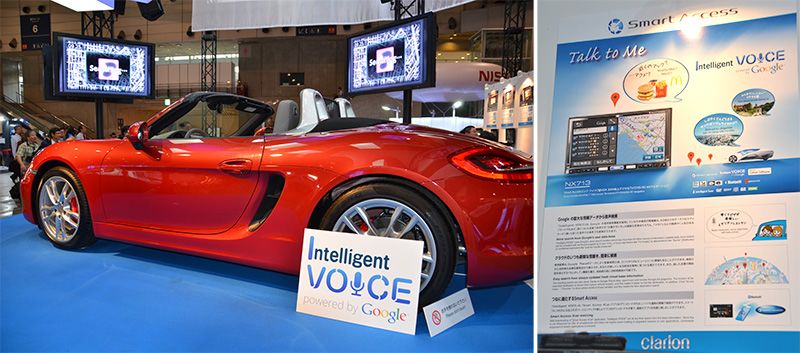 The “Intelligent Voice” system on display at the Clarion booth.
The “Intelligent Voice” system on display at the Clarion booth.
Coming Soon: Energy Management Systems
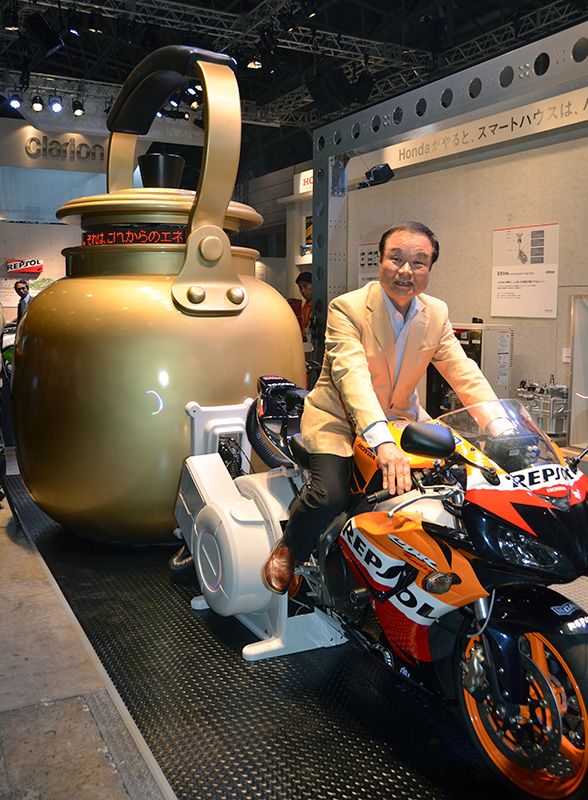 Honda President Itō Takanobu astride a motorcycle that’s heating a giant kettle.
Honda President Itō Takanobu astride a motorcycle that’s heating a giant kettle.
CEATEC exhibits devoted to home energy management systems also highlighted the common ground between electronics and automobiles. These systems make it possible to manage energy usage throughout the home with a single device and operate household electric devices remotely. Honda, making its first appearance at CEATEC, displayed a compact electric vehicle equipped with a tablet computer that can be used to turn household lights and appliances on and off. What really grabbed people’s attention, however, was a giant kettle sitting in the middle of the Honda booth. The kettle was the striking symbol of Honda’s new household cogeneration system, which recovers engine heat to boil water and provide power for household use. A video playing at the booth showed the giant kettle of water brought to a boil by heat from a motorcycle engine started up at the beginning of a presentation by Honda President Itō Takanobu on the first day of the exhibition. The demonstration was part of Honda’s campaign to highlight its entry into a new field.
For the second year in a row, Toyota Motors cosponsored a home energy exhibit with its subsidiary, the home builder Toyota Home. Toyota also displayed a wireless charging system for hybrid vehicles, part of a comprehensive household energy management system encompassing both cars and electric-powered devices inside the home, reported to be coming soon.
CEATEC 2013 featured a remarkable selection of exhibits devoted to technology not only for cars but for household use as well, transcending the barrier between the electronics business and the automobile industry. As cars become increasingly computerized and electric cars enter the mainstream of commercial viability—amid observations that the automobile is being remade into an electrical appliance—two industries that have long stood apart may soon stand together.
(Originally written in Japanese by Nagasawa Takaaki in October 2013.)
electronics cars Fujitsu Nissan automobiles Honda Toyota CEATEC Mazda Pioneer Clarion Google